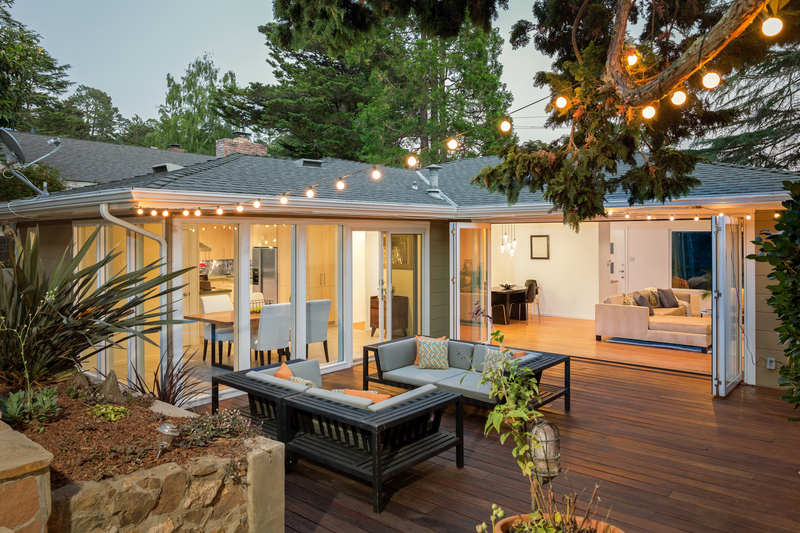Design Your Dream Zen Garden for Ultimate Outdoor Peace
Posted on 03/10/2025
Design Your Dream Zen Garden for Ultimate Outdoor Peace
Are you searching for a creative way to transform your outdoor space into an oasis of tranquility? Designing a Zen garden might be the answer you seek. Explore how to build your very own dream Zen garden for ultimate outdoor peace--and unlock a meditative retreat just steps from your home.

What Is a Zen Garden?
A Zen garden, also known as a Japanese rock garden or karesansui, represents a stylized landscape crafted for contemplation and reflection. These gardens originated within the Buddhist tradition in Japan centuries ago. Their timeless aesthetic--marked by simple lines, strategic placement of rocks, and serene raked gravel--invites peace and mindfulness.
Key Elements of a Zen Garden
- Gravel or sand carefully raked into patterns to symbolize water
- Rocks positioned in meaningful arrangements, symbolizing mountains or islands
- Minimalist, harmonious touches from plants, moss, and small trees
- Simple ornaments like lanterns, bridges, or water bowls
The Philosophy Behind Zen Garden Design
Zen gardens are not just visually beautiful--they're rooted in deep philosophy. The act of designing and tending to your Zen garden can foster mindfulness, reduce stress, and promote inner calm. The minimalist approach encourages you to let go of excess and focus on the essentials, making your outdoor retreat a pure, uncluttered space.
Symbolism in Zen Gardens
- Sand or Gravel: Represents water, rivers, oceans, or calmness
- Rocks: Symbolize mountains, strength, endurance, or islands of tranquility
- Moss: Stands for age, longevity, and harmony
- Trees and Shrubs: Represent life and natural cycles
By understanding the symbolic elements, you can make intentional choices that reflect your goals for peace and balance in your outdoor Zen haven.
Steps to Design Your Dream Zen Garden
Ready to cultivate serenity in your outdoor space? Follow these comprehensive steps to design a Zen garden tailored to your unique taste and landscape. Whether you have a sprawling backyard or a compact courtyard, these guidelines will help you build a restful environment that fosters ultimate outdoor peace.
1. Choose the Ideal Location
Start by choosing a space that evokes a sense of seclusion and calm. This might be a neglected corner of your yard, a side alley, or the heart of your garden. Even a small patio or balcony can become a personal Zen sanctuary with the right vision.
Consider:- Privacy from neighbors and street noise
- Natural lighting conditions (dappled sunlight is ideal)
- Easy access for maintenance and enjoyment
- Ground conditions - a flat, well-drained area is best
2. Plan Your Zen Garden Layout
Sketch the design before you start. Think about how the elements will be arranged for the greatest impact. Consider the principle of asymmetry; traditional Zen gardens are rarely symmetrical, emphasizing the imperfect beauty of nature.
Tips for Your Zen Garden Plan:- Map out major features: gravel beds, rock groupings, pathways, and accent plants
- Envision the space from multiple perspectives *
- Leave open areas for simplicity and "ma" (negative space)
- Use a scale drawing for larger gardens
3. Prepare the Ground
To give your Zen oasis a polished look and prevent future problems, prepare the site thoroughly:
- Clear debris, weeds, and grass
- Level the surface, adding or removing soil as needed
- Lay a weed barrier fabric to minimize maintenance
4. Define the Boundaries
Frame your garden with borders of stone, wood, bamboo, or low fencing. Boundaries help contain your gravel or sand and enhance the feeling of enclosure--essential for tranquility.
5. Place the Rocks
Rocks form the "bones" of your Zen landscape. Select smooth river stones, rugged boulders, or artistically shaped rocks to anchor your design. Vary sizes and shapes for natural harmony.
Arranging Zen Garden Stones:- Group rocks in odd numbers (often 3, 5, or 7)
- Position some rocks upright and others flat for visual interest
- Bury a portion of each rock for stability and authenticity
- Let certain rocks symbolize mountains, islands, or focal points
Reflect on the meaning and placement of each stone--each should feel intentional and balanced.
6. Add Gravel or Sand
Spread a generous layer of white or beige gravel, or sand, throughout the garden. Rake it smoothly, then gently create swirling or linear patterns with a special rake (or improvise with a garden fork). These patterns evoke rippling water and bring soothing movement to stillness.
Zen Raking Patterns to Try:- Circles around rocks to suggest islands in a sea
- Parallel lines for waves or flowing rivers
- Meandering swirls to channel movement and change
7. Incorporate Minimal Plants and Accents
Keep plantings restrained and choose varieties that reinforce tranquility. Avoid riotous colors or overly busy textures.
Recommended Zen Garden Plants:- Moss (sheet moss or cushion moss)
- Bamboo (in containers for control)
- Japanese maple (Acer palmatum) for delicate beauty
- Ferns, hostas, or mondo grass for lush green accents
Accent your dream garden with stone lanterns, small water features, or wooden bridges for subtle beauty. Each addition should feel carefully curated and never cluttered--less is often more in Zen design.
8. Create Pathways and Seating
Graceful stepping stones, wooden decks, or pea gravel pathways allow you to wander and linger within your Zen retreat. Place a low bench, boulder, or simple stool for meditation or quiet reflection.
- Seat placement: Choose a spot with the best view or a hidden corner for privacy
- Paths: Design them to flow naturally, encouraging slow, mindful walking
How to Maintain Your Zen Garden Oasis
A Zen garden should be easy to maintain, yet the small rituals of tending to it can become a form of meditation in themselves.
- Rake gravel or sand regularly to refresh patterns
- Remove leaves and debris for a tidy look
- Trim plants and control moss or weeds gently
- Reposition rocks only when necessary--stability symbolizes steadfastness
These gentle tasks connect you to the present moment, nurturing your garden's spirit as well as your own.
Zen Garden Design Tips for Ultimate Outdoor Peace
To truly cultivate outdoor peace and serenity, consider a few additional design touches:
- Embrace Imperfection (wabi-sabi): Relish the beauty of weathered rocks, aged wood, and mossy growth. Perfection is not the goal--authenticity is.
- Use Subtle Sound: Add a bamboo fountain, wind chimes, or a softly bubbling water bowl. Gentle sounds enhance relaxation and mask street noise.
- Incorporate Lighting: Use solar lanterns or soft, low-voltage lights to illuminate pathways or highlight sculptural stones after dark for an ethereal effect.
- Practice Mindfulness in Maintenance: Approach gardening as a meditative ritual that soothes the mind and supports mental clarity.
- Make It Personal: Choose elements and symbols that resonate with your life journey or aspirations--let your Zen garden design reflect your story.
Zen Gardens for Small Urban Spaces
Even city dwellers with compact courtyards or balconies can design a magical miniature Zen retreat:
- Use a shallow ceramic or wooden tray as your "garden bed"
- Arrange tiny stones and fine-grain sand for intricate patterns
- Place a tiny lantern, bonsai tree, or jade plant for authenticity
- Maintain your desktop garden as a daily mindfulness practice
A personal Zen corner offers instant calm, whether it's outdoors, on your patio, or beside your workspace.

Frequently Asked Questions About Designing Zen Gardens
What is the cost to create a Zen garden?
Budget varies widely based on size, material quality, and DIY vs. professional installation. A small DIY Zen garden might cost less than $200, especially if you repurpose rocks and use mulch, gravel, or found wood. Larger landscapes or ornate features can cost several thousand dollars. Remember, simplicity is essential--focus on quality over quantity.
Can I use grass in my Zen garden?
Traditionally, karesansui gardens avoid grass, favoring gravel, sand, and moss for a low-maintenance, dry landscape look. However, you can incorporate Japanese-style grass pathways or ornamental clumps if desired. Always keep plantings sparse and intentional.
Are Zen gardens suitable for pets and children?
Yes--but bolder stones, child-friendly rakes, and durable pathways will make your outdoor Zen sanctuary more family-friendly. Just be aware that sand and gravel may invite play, so adjust your expectations or create a dedicated family Zen zone.
Conclusion--Embrace Outdoor Peace with Your Dream Zen Garden
Designing your dream Zen garden invites peace, focus, and natural beauty to your outdoor living space. By blending ancient philosophy with minimalist style, you'll cultivate a sanctuary that nurtures mind, body, and spirit--the true essence of ultimate outdoor peace.
Start small, let your intuition guide you, and enjoy the ongoing ritual of Zen gardening. With each stone you place and every gravel pattern you rake, you'll be one step closer to serenity, mindfulness, and the outdoor harmony you've always dreamed of.
- Ready to create your own oasis? Begin planning your Zen garden design today and transform your backyard into a peaceful haven.
- Share your journey: Connect with other creators and inspire friends with your unique outdoor Zen retreat.
Unlock the beauty of Zen simplicity--and claim your own corner of outdoor peace.

